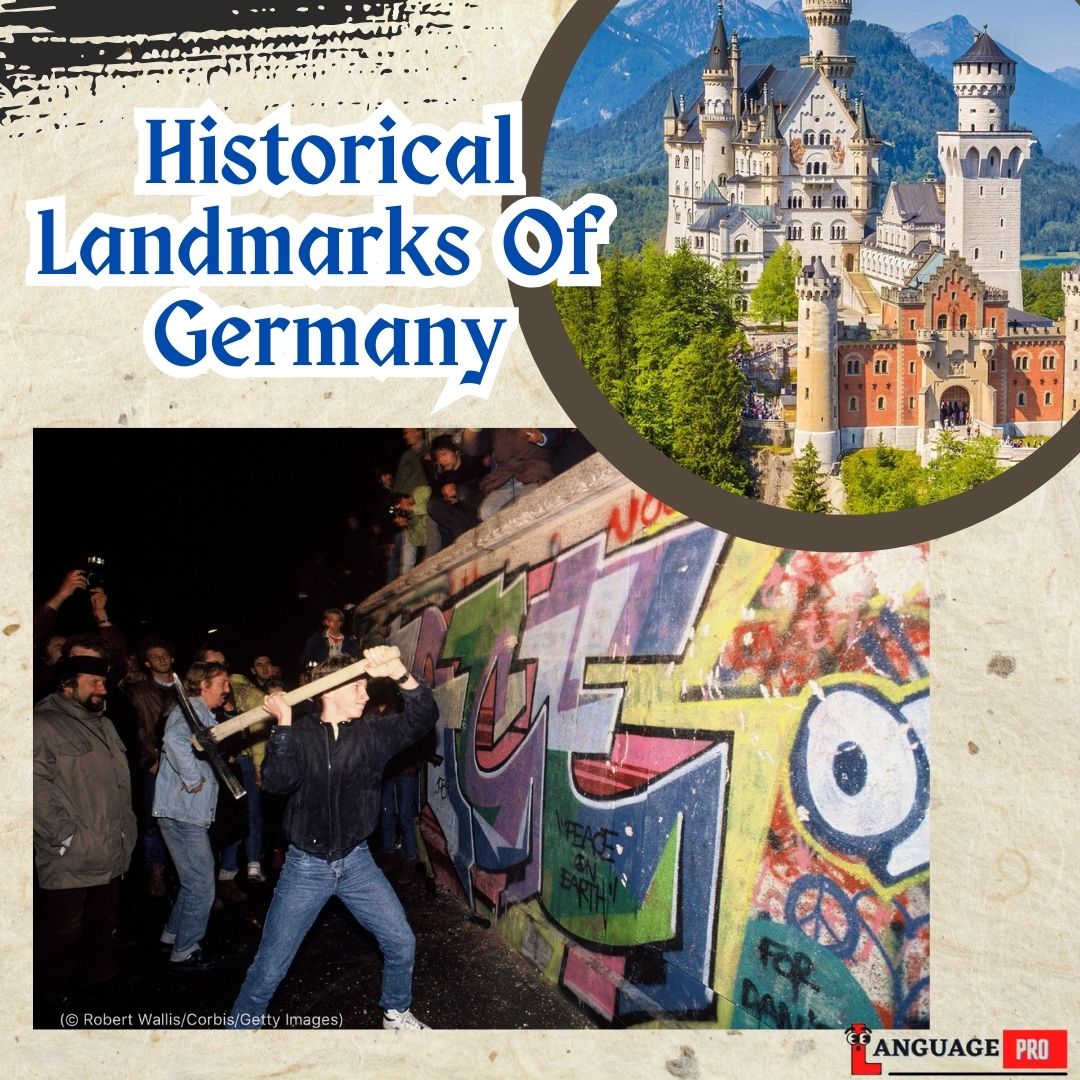Table of Contents
- Historical Landmarks of Germany
Historical Landmarks of Germany
Introduction
Germany’s landscape is adorned with the historical landmarks of Germany that narrate tales of the past, from the formidable Berlin Wall to the enchanting Neuschwanstein Castle. Let’s embark on a journey through time and explore the captivating history behind these iconic structures. Germany, with its deep-rooted history, stands as a testament to resilience and cultural richness. The historical landmarks scattered across the country reflect the nation’s evolution through various eras, each contributing to the mosaic of Germany’s identity.
Berlin Wall
Construction and history of the Berlin Wall
The Berlin Wall, erected in 1961, was a physical and ideological divide between East and West Germany. Explore the motives behind its construction and the impact it had on the lives of Germans during the Cold War.
Fall of the Berlin Wall
The fall of the Berlin Wall in 1989 marked a symbolic end to the Cold War. Delve into the events leading to this historic moment and the subsequent reunification of Germany, shaping the nation’s destiny.
Neuschwanstein Castle
History and architectural marvel
Neuschwanstein Castle, a fairytale-like edifice, holds secrets of Bavarian history. Uncover the visionary Ludwig II’s role in its creation and the architectural brilliance that makes it a must-visit destination.
Ludwig II and his vision
Learn about Ludwig II, the eccentric king whose dreamy vision gave rise to Neuschwanstein Castle. Discover the monarch’s impact on the castle’s design and his influence on the cultural landscape of Bavaria.
Tourist attractions and significance
Neuschwanstein Castle isn’t just a castle; it’s a cultural icon. Navigate through the castle’s significance, popular attractions within its walls, and the allure that draws millions of visitors annually.
Historical Evolution
Key periods shaping Germany’s landmarks
Germany’s historical landmarks reflect the nation’s journey through different epochs. From medieval fortresses to modern wonders, explore the diverse architectural styles that define each era.
Medieval era landmarks
Journey back to the medieval era and explore iconic landmarks that withstood the test of time. Discover how castles and cathedrals became symbols of power and prestige.
Renaissance and Baroque influences
The Renaissance and Baroque periods brought forth architectural marvels. Uncover the influence of these artistic movements on landmarks like Heidelberg Castle and the Cologne Cathedral.
19th and 20th-century developments
Witness the transformations brought about by the 19th and 20th centuries. From the industrial revolution’s impact on cities to the devastation of World War II, understand how landmarks adapted to changing times.
Post-war reconstruction
Germany’s commitment to reconstruction after World War II is evident in its landmarks. Explore the resilience displayed in rebuilding structures like the Frauenkirche in Dresden.
Iconic Landmarks
Brandenburg Gate
As a symbol of unity, the Brandenburg Gate stands proudly in Berlin. Discover its historical significance and role in shaping Germany’s political landscape.
Cologne Cathedral
A masterpiece of Gothic architecture, the Cologne Cathedral dominates the skyline. Uncover the stories behind its construction and the cultural importance it holds.
Reichstag Building
The Reichstag Building, home to the German parliament, is a blend of history and modernity. Explore its tumultuous past and its role in contemporary politics.
Heidelberg Castle
Perched on the hills, Heidelberg Castle is a romantic ruin with tales of love and war. Immerse yourself in its history and panoramic views of the Neckar Valley.
Nuremberg Castle
Nuremberg Castle, a medieval marvel, echoes tales of imperial history. Explore its role in shaping the medieval city and its significance today.
Lesser-known Gems
Wartburg Castle
Hidden in the Thuringian Forest, Wartburg Castle is a literary treasure. Discover its connections to Martin Luther and the creation of the first German translation of the Bible.
Rothenburg ob der Tauber
Step into a fairytale in Rothenburg ob der Tauber. Explore its well-preserved medieval architecture and immerse yourself in the charm of this picturesque town.
Speicherstadt in Hamburg
The Speicherstadt in Hamburg, a warehouse district, is a testament to industrial architecture. Learn about its history and transformation into a UNESCO World Heritage site.
Sanssouci Palace in Potsdam
Sanssouci Palace, the summer retreat of Frederick the Great, is a Rococo masterpiece. Uncover the stories behind its creation and its role in Prussian history.
Cultural Impact
Art and culture surrounding landmarks
Germany’s landmarks are not just architectural wonders; they are hubs of art and culture. Explore the artistic expressions inspired by these landmarks and their influence on German culture.
Literary references
Delve into the literary world connected to Germany’s landmarks. From Goethe’s fascination with Heidelberg to tales inspired by the Wartburg Castle, literature breathes life into these historical sites.
Influence on German identity
These landmarks are more than just structures; they are integral
to Germany’s identity. Understand how they contribute to shaping the collective memory and cultural pride of the German people.
Preservation Efforts
Conservation initiatives
Preserving historical landmarks is a shared responsibility. Explore the various conservation initiatives in place to safeguard Germany’s architectural heritage and maintain the authenticity of these sites.
UNESCO World Heritage sites
Many of Germany’s landmarks have earned the prestigious title of UNESCO World Heritage sites. Discover the criteria for such recognition and the significance it holds for the preservation of these treasures.
Modern Interpretations
Contemporary art at historical sites
Experience the fusion of tradition and modernity through contemporary art installations at historical sites. Witness how artists breathe new life into these landmarks, making them relevant for future generations.
Adaptive reuse of landmarks
Discover how some historical landmarks have found new purposes. From castles turned museums to industrial sites transformed into cultural hubs, witness the adaptive reuse preserving their legacy.
Balancing tradition and modernity
Germany excels in maintaining a delicate balance between tradition and modernity. Explore how this approach ensures that historical landmarks remain relevant in the ever-evolving cultural landscape.
Travel Tips
Planning a historical landmarks tour
Embark on a historical journey with practical tips for planning your landmark tour. From choosing the right season to understanding the cultural nuances, ensure a seamless exploration of Germany’s historical treasures.
Must-visit regions
Germany’s historical landmarks are scattered across regions. Explore must-visit areas, each offering a unique blend of history, culture, and picturesque landscapes.
Cultural events and festivals
Immerse yourself in Germany’s vibrant cultural scene by aligning your visit with historical events and festivals. Discover how these celebrations enhance the overall experience of exploring landmarks.
Conclusion
In conclusion, the Historical Landmarks of Germany, from the Berlin Wall to Neuschwanstein Castle, narrate tales of resilience, cultural richness, and the nation’s evolving identity. Embrace the opportunity to explore these treasures firsthand and become a part of the ongoing legacy that defines Germany’s historical landscape. For more enriching experiences and cultural insights, visit LanguagePro, where we celebrate the beauty of language and the diverse narratives that shape our global heritage.




